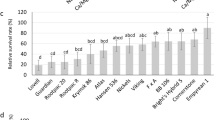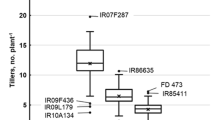Abstract
The effects of increased salinity [NaCl + CaCl2] on seedlings of five accessions of pearl millet grown for 2 and 7 weeks, respectively, in salinised solution cultures at EC 0.6, 4, 8, 12, 16, and 20 ds m−1 and sand cultures at EC 0.6 and 20 were assessed. There were no consistent relationships between seedlings characters at two and seven weeks in response to increased salinity, and no single character provided an acceptable means of differentiating cultivar/line response. The line having lower shoot mortality had a high root weight, a shoot:root ratio approaching 1, the greatest shoot water content, and the greatest plant height. No relationship was found between these whole-plant characters which suggest greater salinity tolerance, and the pattern of ion distribution, particularly Na+ and Cl−. Sufficient inter-cultivar/line variation in response to salinity was found to suggest that selection of individuals with increased salinity tolerance is possible within pearl millet.
Similar content being viewed by others
References
Akbar M and Yabuno T 1974 Breeding for saline resistant varieties of rice. Comparative performance of some rice varieties to salinity during early developmental stages. Japan. J. Breed. 24, 176–181.
Allard R W 1960 Principles of plant breeding. Wiley, New York.
Ashraf M, McNeilly I and Bradshaw A D 1986a. The potential for evolution of salt (NaCl) tolerance in seven grass species. New Phytol. 103, 299–309.
Ashraf M, McNeilly T and Bradshaw A D 1986b Selection and heritability of tolerance to NaCl in four forage species. Crop Science 27, 232–234.
Dehan K and Tal M 1978 Salt tolerance in the wild relatives of the cultivated tomato: Responses ofSolanum penellii to high salinity. Irrig. Sci. 1, 71–76.
Epstein E, Norlyn J D, Rush D W, King S, Bury D B, Kelley D B, Cunningham G A and Wrona A F 1980 Saline culture of crops: a genetic approach. Science 210, 399–404.
Flowers I J and Yeo A R 1981 Variability in the resistance of sodium chloride salinity within rice (Oryza sativa) varieties. New Phytol. 88, 363–374.
Hewitt E J 1966 Sand and water culture methods in the study of plant nutrition. Comm. Agric. Bur. Tech. Comm. No. 22. 2nd Edn. CAB Slough U.K.
Kingsbury R W and Epstein E 1984 Selection for salt resistant spring wheat. Crop Sci. 24, 310–315.
Maas E V and Hoffman G J 1977 Crop salt tolerance — current assessment. J. Irrig. Drainage Div. Am. Soc. Civ. Engrs. 103, 115–134.
Markin E and Waisel Y 1986 Mass selection for salt resistance in Rhodes grass (Chloris gayana). Physiol. Plant. 66, 443–446.
O’Leary I W 1979In Arid Land Plant Resources. Eds. J R Coodman and D K Norrington, p. 574. ICASALS, Lubbock, Texas.
Ponnamperuma E N 1977 Screening rice for tolerance to mineral stresses. IRRI Research Paper Series 6, 22 pp.
Ream C L and Furr J R 1976 Salt tolerance of someCitrus species, relatives and hybrids, tested as root stocks. J. Am. Soc. Hort. Sci. 101, 265–267.
Rush D W and Epstein E 1976 Genotypic responses to salinity: differences between salt-sensitive and salt-tolerant genotypes of tomato. Plant Physiol. 57, 162–166.
Shannon M C 1978 Testing salt tolerance variability among tall wheatgrass lines. Agron. J. 70, 719–722.
Shannon M C 1984 Breeding, selection, and the genetics of salt tolerance.In Salinity Tolerance in Plants. Eds. R C Staples and G H Toeniessen, pp 231–254. John Wiley and Sons, New York.
Silvey V 1978 The contribution of new varieties to increasing cereal yield in England and Wales. J. Nat. Inst. Agric. Bot. 14, 367–384.
Tal M 1971 Salt tolerance in the wild relatives of the cultivated tomato: Responses ofLycopersicon esculentum. L. peruvianum, andL. esculentum minor to sodium chloride solution. Aust. J. Agric. Res. 22, 631–638.
Author information
Authors and Affiliations
Rights and permissions
About this article
Cite this article
Ashraf, M., McNeilly, T. Salinity effects on five cultivars/lines of pearl millet (Pennisetum americanum [L] leeke). Plant Soil 103, 13–19 (1987). https://doi.org/10.1007/BF02370662
Received:
Revised:
Issue Date:
DOI: https://doi.org/10.1007/BF02370662




